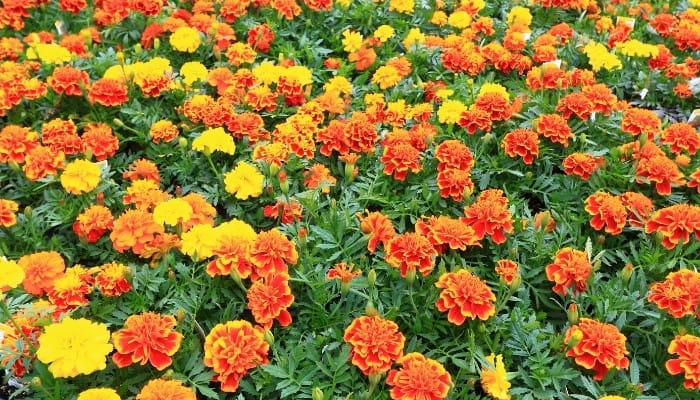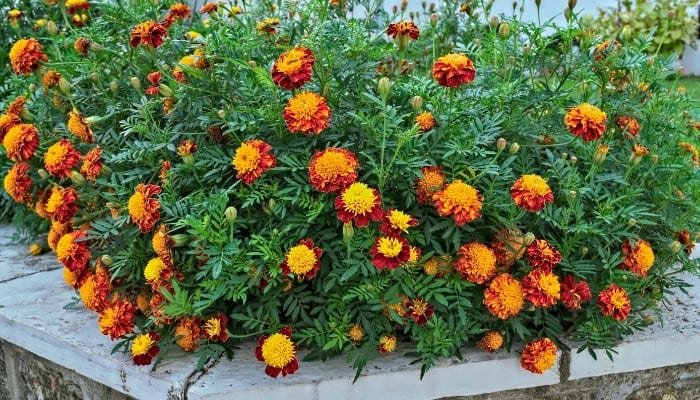Marigolds are a well-liked type of flower that is often used in landscaping or gardening. These flowers come in a variety of colors including red, yellow, and orange, all of which are visually appealing. Marigolds require less maintenance compared to other flowers and will continue to bloom each year with some assistance. However, what is the recommended course of action for Marigolds at the conclusion of the growing season?
Annual marigolds are frost-tender plants and will die in late fall after temperatures drop below freezing. Cut back the marigolds to the ground with clean shears, or simply pull them up roots after they die completely. Remove the trimmings from the bed so they don’t harbor pests over winter.
Marigold plants require six hours or more of sunlight, watering twice per week, and pruning at the end of the gardening season. In the following, we discuss exactly what to do with marigolds at the end of the season in more detail, including how to harvest and save seeds, prepare the bed for winter, and more.
Key Takeaways: Marigold plants
- Benefits of Uprooting the Plant: Uprooting marigolds after the first frost prevents them from regrowing and helps in garden maintenance. It also aids in pest control by removing plant debris that could harbor pests over winter.
- Perennial Growth: Marigolds, often treated as annuals, can reappear each year if they self-seed. To ensure growth every year, it’s vital to harvest and preserve seeds and plant them in spring.
- Seed Preservation and Vital Care Tips: To preserve marigold seeds, dry them and store them in a paper envelope or jar after harvest. The most important care tip is ensuring adequate sunlight, watering, and avoiding overhead watering to prevent diseases. Applying mulch and light fertilization are also key to healthy marigold plants.
End-of-Season Marigold Care
- Sunlight Absorption: Ensure your marigolds get plenty of sunlight before winter. This helps them absorb energy for viable seed production and maintain their vibrant colors.
- Watering Needs: The second step involves adequate watering. Ensure the soil around the marigold plants is well-saturated, penetrating deeply, especially since they require ample moisture during this growing season. Aim to water them twice per week.
- Mulching: Cover the soil of marigolds with mulch, leaving space around the main stem to avoid rot. This step is crucial for protecting the plant and soil.
- Pruning for Growth: The final step is pruning. Cut flowers and damaged parts to encourage new growth. This is important for having a healthy display of flowers up to the first frost.
How to prune Marigolds?
Harvesting Marigold Seeds
To harvest and save marigold seeds is rather simple:
- Cut the dried flowers/seed pods from the flowers when they turn brown (or cut the entire plant down to 2 or 3 inches from the ground).
- Allow the flowers to dry in an open-air space with little moisture if they aren’t crispy.
- Remove the flower heads from the stem (you can save them as is or separate them even further at this point as the seeds are in clusters)
- Place the seeds inside a paper envelope or a mason jar (make sure to label them).
How To Save Marigold Seeds?
- Harvest When Ready: Collect the seeds when the marigold plants die back at the end of the growing season. It’s important to wait until the flower heads have dried on the plant.
- Dry and Separate Seeds: After cutting the flower heads, spread them in a warm, dry area. Once fully dry, carefully open the heads to harvest marigold seeds. This process is essential to ensure the seeds are viable for next season’s growing marigolds.
- Proper Storage: For storage, it’s best to use paper envelopes. Label each with the type of marigold, such as ‘French Marigold’ or ‘African Marigold’. Storing seeds in a cool, dry place is needed to maintain their viability until it’s time to sow them in your vegetable garden or flower bed next season.
What To Do With Dead Marigolds?
When you are done with your marigolds for the year, you may opt either to pull them up by their roots (so they won’t grow back again) or to prune them down to the ground after the first frost hits them.
Apply Mulch
Applying mulch at the end of the season is a great way to ensure that your garden plot isn’t overtaken by early spring weeds, and the mulch also helps hold in moisture.
Wait Until Spring To Plant Seeds
Marigolds may self-seed and produce volunteer plants all by themselves the following spring, but you need to wait until the spring before you plant your own seeds. Technically, seeds sown early may survive the winter, but there’s no use risking perfectly good seeds (especially when they won’t grow until spring anyway).
Marigold Growing Tips

1. Water Often
Marigolds do best when they are watered often, but you should let the soil dry out almost completely before watering. Quick-draining soil works best for these flowers.
2. No Overhead Watering
Avoid overhead watering as it leads to pests, fungus, and other needless damage to your flowers. Instead, water only the bottom of the plants, directly at the bottom of the main stem at the root zone.
3. Pinch Tops and Damaged Areas
Pinching the tops off promotes new growth as does removing damaged areas of the plant. This can be done by hand, with fingers, or with scissors or pruners.
When flowers fade and turn brown, remove them.
4. Use Mulch
Mulching helps protect the soil and prevents weed growth. It also helps keep certain pests away as well as holding more moisture in the soil.
If you do use mulch on your marigolds, avoid putting it all the way up to the plant’s stems (this can cause rotting).
5. Lightly Fertilize
Marigolds don’t require much fertilizer (if any) as long as they are growing in semi-healthy soil. For that reason, heavily fertilizing them will end up burning them.
If you want to fertilize these flowers, do so lightly with an all-purpose fertilizer, like this organic plant fertilizer.
If you need an idea on what the best garden companion plants for Marigolds are, you can find it in this article.
Frequently Asked Questions (FAQ)
Are Marigolds Self-Pollinating?
Marigolds are the type of flowers that need to be pollinated by insects. This is called cross pollination. Sometimes even the wind is enough to pollinate flowers.
If pollen from another kind of flower is introduced to your marigolds from bees you may even end up with a hybrid flower.
Will Marigold In Your Garden Reseed Themselves?
Marigolds are commonly known for their ability to reseed themselves, a trait that makes them perfect for gardeners seeking low-maintenance plants.
After the marigold flowers bloom and last, the petals fall, leaving behind seed heads. If left undisturbed, these seeds naturally fall to the ground and, under the right conditions, will germinate in the following seasonal cycle. Marigolds can self-seed and spread, often giving gardeners new plants in unexpected places.
Why Won’t My Marigold Seeds Germinate?
If your marigolds aren’t germinating properly, know that the main reason is due to lack of adequate light.
Make sure that your marigold seeds are covered with at least a quarter-inch of soil or growing medium and place them in a bright, protected location, keeping the soil evenly moist until germination occurs.
What Pests Are Attracted To Marigolds?
Marigolds can sometimes attract garden pests like aphids, spider mites, slugs and snails, whiteflies, and thrips. Despite this, they are often used effectively as trap crops in gardens for pest control, drawing these pests away from more vulnerable plants.
To learn about other plants that can be used for pest control, read ‘32 Best Trap Crops for Pest Control and How To Use Them.’
Types Of Marigold Flowers
Marigolds are a diverse group of flowering plants; they are easy plant to grow, and popular for vibrant Here are some common types of marigold flowers:
- African Marigolds (Tagetes erecta) (Source)
- French Marigolds (Tagetes patula) (Source)
- Signet Marigolds (Tagetes tenuifolia) (Source)
- Triploid Marigolds (Hybrid of French and African Marigolds) (If interested in price and where t buy you can check here)
- Pot Marigolds (Calendula officinalis) (Not true marigolds, but often grouped with them) (Source)

